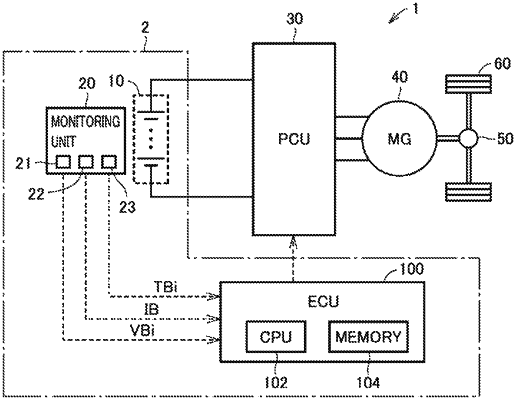| CPC B60L 58/13 (2019.02) [B60L 53/62 (2019.02); H01M 10/345 (2013.01); H01M 10/443 (2013.01); H01M 2220/20 (2013.01)] | 6 Claims |

|
1. A battery system comprising:
a nickel-metal hydride battery; and
a controller configured to control charging and discharging of the nickel-metal hydride battery, wherein the controller is further configured to:
calculate a discharge electricity amount showing an integrated value of a current discharged from the nickel-metal hydride battery,
calculate a state of charge (SOC) variation range of the nickel-metal hydride battery in a prescribed time period,
calculate a charge reserve capacity of the nickel-metal hydride battery based on a temperature of the nickel-metal hydride battery, the discharge electricity amount, and the SOC variation range,
calculate a first amount of increase in discharge reserve capacity using a previously obtained correlation among the temperature, time, and an amount of increase in a discharge reserve capacity of the nickel-metal hydride battery,
correct an amount of decrease in the discharge reserve capacity with a previously obtained coefficient to calculate the amount of decrease corrected by a negative electrode SOC of the nickel-metal hydride battery,
perform control to suppress a decrease in the charge reserve capacity based on the calculated charge reserve capacity decreasing below a threshold value,
calculate the first amount of increase in discharge reserve capacity, wherein the first amount of increase in discharge reserve capacity shows the amount of increase resulting from the temperature and the time,
calculate a second amount of increase in discharge reserve capacity using a previously obtained correlation of the amount of increase with the temperature, the discharge electricity amount, and the SOC variation range, the second amount of increase in discharge reserve capacity showing the amount of increase resulting from the temperature, the discharge electricity amount, and the SOC variation range,
correct the amount of decrease in the discharge reserve capacity, wherein the amount of decrease in the discharge reserve capacity is calculated from the temperature and time using a previously obtained correlation among the temperature, the time, and the amount of decrease in the discharge reserve capacity, and the previously obtained coefficient is higher in value as the negative electrode SOC of the nickel-metal hydride battery is higher,
calculate the discharge reserve capacity of the nickel-metal hydride battery by subtracting the corrected amount of decrease in the discharge reserve capacity from a total amount of increase in discharge reserve capacity, the total amount of increase in discharge reserve capacity being obtained by adding the second amount of increase in discharge reserve capacity to the first amount of increase in discharge reserve capacity,
calculate a negative electrode capacity of the nickel-metal hydride battery by subtracting an amount of decrease in the negative electrode capacity from an initial negative electrode capacity in an initial state of the nickel-metal hydride battery, the amount of decrease in the negative electrode capacity being calculated using a previously obtained correlation between the total amount of increase in discharge reserve capacity and the amount of decrease in the negative electrode capacity of the nickel-metal hydride battery,
calculate a positive electrode capacity of the nickel-metal hydride battery by subtracting an amount of decrease in the positive electrode capacity from an initial positive electrode capacity in the initial state of the nickel-metal hydride battery, the amount of decrease in the positive electrode capacity being calculated using a previously obtained correlation between the discharge electricity amount and the amount of decrease in the positive electrode capacity of the nickel-metal hydride battery, and
calculate the charge reserve capacity by subtracting the positive electrode capacity and the discharge reserve capacity from the negative electrode capacity.
|